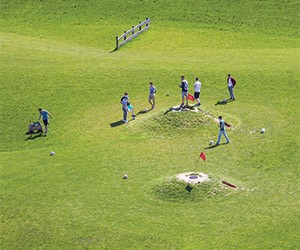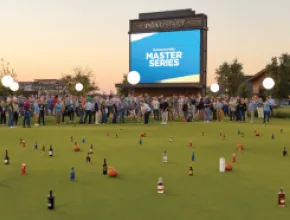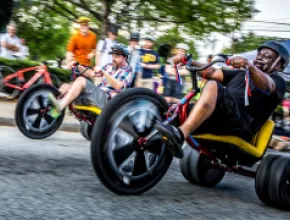Golf is no longer your grandfather’s game. Gen Xers and Millennials view golf differently, and the game has been forced to adapt, especially with meeting groups.
With less time on itineraries for a traditional 18-hole round of golf, which can take up to five or six hours, golf directors and planners now offer a wide variety of options for golf events. From innovative formats designed to speed up play to night golf and FootGolf, golf events today must be creative, time-sensitive and fun.
A golf component in an itinerary is still a superb way to facilitate networking and client engagement as well as reward attendees with a fresh-air reprieve from meeting rooms and laptops. While traditional scramble events remain popular, golf directors have become more adept at altering them to accommodate specific time requirements and food, beverage and entertainment elements.
Enhancing golf’s overall appeal are new venues like high-tech golf entertainment complexes suitable for group functions and connected golf carts that allow for tournament software and listening to music on the fairways.
Time-Savers
High on the list of golfers’ pet peeves these days is slow play. Planners abhor slow, arduous rounds of golf, too, because time overruns often cause players to be late to important dinner functions and evening activities.
Jennifer Dalsbo, recreation sales manager for the Grand Geneva Resort and Spa in Lake Geneva, Wis., presents a creative way for midsize groups of 30 to 60 players to speed up play and reduce the sense of hurriedness.
“We suggest a modified shotgun tournament format, but have the group buy out a few tee times in front and back of them for a few extra dollars,” Dalsbo said. “It will ensure that no other groups or individuals are ahead of them, so they can play at their own pace and not be slowed by others. I’ve had a few groups do this, and we’ve had great results.”
To speed up a traditional scramble format, Curtis Ohrn, director of golf at Pursell Farms, a 3,200-acre golf resort 45 minutes from Birmingham, Ala., suggests all players hit at the same time except for the putting green.
Other ideas Ohrn uses to shorten the scramble tournament, especially for lesser-skilled players, include:
- Have players tee the ball up on every shot.
- No search time for golf balls.
- Use a shot clock to ensure each hole must be played in 10 minutes, which would equate to a three-hour round. If a team exceeds the time limit, they’re penalized a double bogey.
- No mulligans.
- A maximum score of par on every hole.
- Automatic two putts. If you don’t make the first putt, you pick up and move to the next hole.
The Boulders Resort & Spa in Carefree, Ariz., recently introduced its Pebble Tees, which have yardages from 100 to 200 yards on nine holes of each of its two championship golf courses.
“There’s an assumption that you must play 18 holes of golf, and new golfers sometimes are discouraged that the game is difficult and they have to make this big commitment to braving it out for hours on the course,” said Ryan McKay, director of golf operations at The Boulders. “The short courses make it less stressful, more fun and easier to get into the game.”
Creative Solutions
“To accommodate groups, especially those with younger players, you must be open to new ideas and options,” says Patrick Dill, director of golf at Omni Orlando Resort at Championsgate in Florida. “Whether it’s allowing a group to play in jeans with craft beer stations on different holes or setting up a putting course surrounded by cocktail stations, you must be flexible and creative to fulfill their needs.”
Golf isn’t just for daytime recreation either.
At Westin Mission Hills Golf Resort & Spa in Rancho Mirage, Calif., a popular event is Cosmic Putting, which consists of a miniature-putting course built with glow-in-the-dark tracks that make up each hole.
Various resorts offer glow-in-the-dark golf outings and planners can assist golf directors in designing the events so they appeal to both golfers and non-golfers.
For groups seeking a fitness component with golf, the latest rage is FootGolf, a hybrid of soccer and golf, in which participants kick a soccer ball into a 21-inch cup on a golf course. Resorts offering FootGolf include Turtle Bay Resort in Kahuku on Hawaii Island; Grand Cypress Resort and Reunion Resort in Orlando; Crystal Springs Resort in Sussex County, N.J.; and Tahquitz Creek Golf Resort in Palm Springs, Calif., to name a few.
Revolutionary Rides
Traversing the golf course has become more fun and exciting these days. An increasing number of resorts feature golf carts with GPS, USB ports and speakers.
“We just added new carts with USB ports,” said Mike Block, director of golf at Omni Amelia Island Plantation in Amelia Island, Fla. “It opens up lots of possibilities for charging phones, GPS devices, speakers and listening to music from phones.”
For an alternative ride on the golf course, Golfboards, a motorized skateboard with space to carry clubs, allows golfers to surf the turf with a sensation much like snowboarding and skateboarding. Golfboards are now available at more than 250 golf courses around the world, including resorts like Boyne Highlands in Harbor Springs, Mich.; Tetherow Resort in Bend Ore.; Mauna Kea Beach Hotel and Hapuna Beach Prince Hotel on Hawaii Island; and Monarch Beach Resort in Dana Point, Calif.
Some golf directors are utilizing Golfboards for other purposes beyond playing golf, such as bird watching, foliage tours and golf course orientation for beginners.
To encourage faster play and enhance social interaction, the Palmetto Dunes Oceanfront Resort on Hilton Head Island, S.C., recently added 12 four-person golf carts equipped with GPS and USB ports.
“In the afternoons, we can host some small corporate outings and scramble tournaments with all four players in the same golf cart,” said Clark Sinclair, Palmetto Dunes director of golf. “We think this will be very attractive to corporate event planners, as it allows an added sense of team and relationship building.”
Alternative Venues
Some groups, especially those with a high percentage of Millennials, are enjoying golf without venturing to the golf course. Dallas-based Topgolf, a hugely popular high-tech driving range concept with high-end restaurants and bars, now has 35 locations and is expanding rapidly.
Combining elements of a traditional driving range, miniature golf, high-tech gadgetry and lighted targets with upscale food and drinks, Topgolf reports that 40 percent of its customers have never even played golf. Players hit golf balls containing computer microchips that track each shot’s accuracy and distance while also awarding points for hitting large, medium and small targets set on a giant outfield.
Like most of its facilities, Topgolf’s newest location in Orlando, which opened in October, is designed with corporate groups in mind. The 65,000-square-foot complex has 102 climate-controlled hitting bays with 3,000 square feet of private event space and meeting rooms, including a rooftop terrace with fire pits for 178 guests and buyouts for up to 1,700 guests. Topgolf’s event staff can customize tournaments, games and clinics to fit group skill levels and needs.
Among the many meeting and convention-oriented cities with a Topgolf facility are Las Vegas; Tampa and Jacksonville, Fla.; Scottsdale, Ariz.; Charlotte, N.C.; and Nashville.
Meanwhile, in Tulsa, Okla., Flying Tee is a tri-level golf, dining and entertainment venue with 60 hitting bays, three hospitality suites and a beer garden suitable for group functions.






